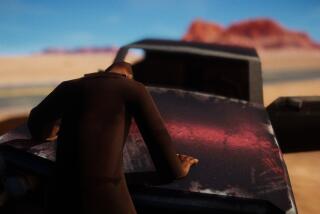Adding Texture, Detail to Miller Brothers’ Legacy
- Share via
In 1993, “Myst” entranced a worldwide audience with its lush graphics, intriguing story line and accessibility for people who had never played computer games.
Created by brothers Robyn and Rand Miller, “Myst” was followed four years later by “Riven,” a game in the same mystery and puzzle-solving genre as “Myst,” but with even more eye candy. “Myst” sold 5.5 million copies, but “Riven” sold only 4.5 million--mostly because many players found the puzzles too difficult.
The Miller brothers in 1999 sold the license to produce the next two “Myst” games in order to concentrate on making a persistent world game based on this well-known franchise. The result is “Myst III: Exile,” produced by Presto Studios and published by Ubi Soft. Dan Irish, the 26-year-old producer of “Exile,” talked about how his team tried to combine the best of “Myst” and “Riven” while still giving players a new experience.
Q: How did you improve upon the original?
A: First, we knew we had new technology that we could use to build the game. Things like the ability of the player to look 360 degrees from any location in the game. We also knew if we created a game that is as beautiful but more realistic than “Riven,” we would blow people away. We’d be at least halfway there. The other half was creating a story and game play that was compelling and interesting to rival “Myst.” Thirdly, we knew we wanted to take it in a different direction by not having the brothers be the central focus, as they were in the first two games. We wanted to introduce a new villain with new character and depth. We think we’ve created a villain that is very complex. There’s no right or wrong ending. But the game presents the player with a series of meaningful choices, the most significant of which is at the end of the game.
Q: How did you try to improve the game play?
A: We wanted to make sure that all game play has immediate feedback. You know what you’re doing and why. Everything has a purpose. There are many different layers of meaning and details in “Myst III.” For example, in the villain’s lair, there are all these details, all of which give important clues. There’s the painting of his wife with her eyes scratched out, small devices on his desk, his diary. All of which hold important clues for later in the game. These elements just make it deeper.
Q: How did you create the music for “Myst III?”
A: The music, of course, was a critical commitment. We had to match or exceed the surrealistic style of music that Robyn [Miller] had pioneered. It had to be recognizable as “Myst,” but unique and distinctive. In the original games, all the music was synthesized. For “Myst III,” we actually hired a full orchestra. Jack Wall [the composer] and Presto Studios decided to create a dynamic implementation of the music so that you would hear something completely different and unique based on where you happen to be located. If you were near an ocean you’d hear waves crashing and music that conveys an open, breezy ambience. As you get closer to the water, the wave sounds would be louder. The game knows your exact location and plays music and sounds that are appropriate to that location and the situation you’re in.
Q: How did you develop the program for playing the music?
A: Jack would take the music from the symphony recording, mix it with his own music and break it down in smaller parts that could be integrated with the game in a dynamic way that sounded seamless. Then he worked with programmers at Presto to develop a formula for how those pieces would be put together based on what the player was doing within the game and where they were in the story. It is interactive music. I haven’t seen it in any other game. There are literally thousands of individual musical elements that can be combined.
Q: The game comes in four CD-ROMs and takes up 2.1 gigabytes of hard drive space. Why is it so big?
A: Riven was four CDs as well. For this game, we wanted the game to have at least as much depth as “Myst” but in a world that was as elaborate as “Riven.” Most of the data is the environment. The puzzles or the game play really don’t take up much space at all in comparison. The attention to detail had to be extreme. There are 80,000 individually modeled leaves in the game. The J’nanin Age has in excess of 1.9 million polygons at any single outdoor location. We’re talking 190,000 to 360,000 polygons for “Riven.” We did this because we wanted to make the world feel as if it was alive. You have the ability to interact with all the animals and plants in a real and convincing way. Plus, we didn’t want to disappoint people by making the experience too shallow or too quick.
Q: Part of the success of “Myst” was its ability to captivate people who have never played computer games before. How did you try to make this game accessible to new players?
A: We tried to make the puzzles have immediate feedback so users would know the cause and effect of their actions. That removed some of the frustration users had in “Riven,” where some puzzles felt arbitrary. We also made the interface very seamless and easy to use. All you need to do is move the mouse and click left or right.
Myst pioneered the mass-market acceptance of video games as an art form, and we wanted to continue that tradition. If you look at “Myst,” “Riven” and “Myst III,” they’re known for their artistic beauty. That’s something everybody can understand. We’d like the industry to progress toward being more a work of art like music or movies. “Myst” opened up the market to people who wouldn’t normally play video games. Here was an experience everybody could enjoy.
Q: How involved were Robyn and Rand Miller in this project?
A: It was very limited. They gave us the canvas with which to paint the picture; it was up to us to pick what type of paint to use and how to combine the colors to create the masterpiece.
Q: Did you get any feedback from them on the final product?
A: Rand said he was really looking forward to playing a Myst game without knowing what happens at the end. He loved the game.
*
Times staff writer Alex Pham covers the video game industry.
More to Read
The biggest entertainment stories
Get our big stories about Hollywood, film, television, music, arts, culture and more right in your inbox as soon as they publish.
You may occasionally receive promotional content from the Los Angeles Times.










